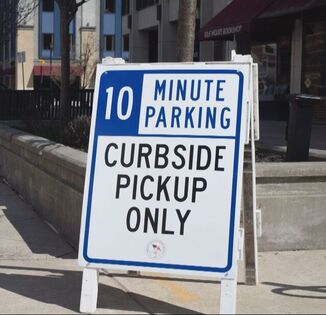The green light for curbside pickup was designated for such as book stores, clothing stores, sporting goods, toy stores and florists, given they follow additional safety protocols. In making the announcement, Newsom made it clear that the state wouldn’t necessarily apply to counties with stricter rules.
One day later, Marin County Public Health Officer Matt Willis made it clear that Marin would be one of those communities that was not yet ready to allow retails to open for curbside pickup.
“We will not be making new allowances for curb-side retail this week, but will be planning toward an opening of these activities May 18,” he said.
Willis told the Marin Independent Journal that Newsom “didn’t give us a lot of advanced warning in terms of making sure that were really prepared to bring that sector on board. We need a little more time to make sure our business owners understand the safety practices and can implement them.”
Those additional safety practices for retailers to open for curbside pickup only, Newsom said Thursday, include vigilant social distancing between customers and employees; installation of hands-free devices such as contactless payment processing; extensive availability of hand sanitizer; all parties involved wearing masks; and employees wearing gloves when handing off products during curbside pickup.
“This is a very positive sign and it has happened for only one reason: the data says it can happen,” Newsom said. “But we recognize as we begin to modify … possible community spread will occur. If that is the case, and we don’t have the capacity to control that spread, to track that spread, to isolate individuals that may have been in contact with COVID-19, we will have to make modifications anew.”
Newsom said the state is also working to create guidelines that will allow restaurants and other hospitality businesses to open their doors again. “We will only allow for seated dining in restaurants when we can put out guidelines with specifications on how those restaurants are set up, when the data in your region can be supported so that we don’t have spread.”
With that moment in mind, the Mill Valley Chamber has been consulting with business owners across a range of industries about their desire to have dedicated parking spaces designated for curbside pickup, both for retail and for restaurants, particularly those businesses without their own off-street spaces. City officials have supported this concept and those changes could be implemented in the coming weeks.
With continued progress toward a reopening, the County of Marin launched Marin Recovers, a website focused on communicating the progress through “three broad phases. Each phase has criteria that must be met before moving to the next phase to continue our successful mitigation of COVID-19 while building the infrastructure needed to move forward. This outlines our process to engage our community as we take steps to rebuild.”
A major component of the Marin Recovers specific to the reopening of the economic are Industry Advisors, groups of experts in specific sectors of the Marin community who can provide guidance to Willis and his team across all activities and industries. Advisors will represent both small and large organizations within the following: restaurants; retail; construction; parks/outdoor recreation/golf courses; general office space; summer camps and youth activities, transportation; hotels/motels/hospitality; personal services; small business; arts.
Katie Rice, President of the Marin County Board of Supervisors, describes the goals and future of Marin Recovers below:
- Perform a detailed risk assessment
- Train employees on limiting spread, how to screen for symptoms, and to stay home if sick
- Implement a site-specific protection plan, cleaning and disinfecting protocols, and physical distancing guidelines
Ghaly also outlined a process by which counties like Marin can have their own variations on state guidelines in Phase 2. He said full guidelines on that process will be released Tuesday, May 12, but said counties would be required to at least meet the following:
Epidemiologic stability
- No more than 1 case per 10,000 people in the last 14 days
- No COVID-19 deaths in the past 14 days
Protection of Stage 1 essential workers
- Ability to support employees when sick or exposed
- Availability of disinfectant supplies and protective gear
Testing capacity
- Minimum daily testing of 1.5 per 1,000 residents
Containment capacity
- At least 15 contact tracers per 100,000 residents
- Ability to temporarily house at least 15% of county residents experiencing homelessness
Hospital capacity
- County or regional capacity to accommodate a minimum surge of 35%
- Hospital facilities msut have a robust plan to protect hospital workforce
Vulnerable populations
- Skilled nursing facilities must have moer than 14-day supply of PPE on hand for staff with ongoing procurement from non-state supply chains
Triggers for adjusting modifications
- Metrics that serve as triggers for either slowing the pace through phase 2 or tightening modifications
As Newsom announced late last month, the state plans to reopen in four stages. Here again are those phases:
Stage 1: Everyone is either staying at home or a member of the essential workforce. This is the stage we are in now, and will stay in until a modification to the statewide stay-at-home order.
Stage 2: Reopening lower risk workplaces, including:
- Non-essential manufacturing (toys, furniture, clothing, etc.)
- Schools
- Childcare facilities
- Retail businesses for curbside pick-up
- Offices where working remotely isn’t possible, but can be modified to make the environment safer for employees
Stage 3: Reopening higher risk workplaces, which require close proximity to other people, including:
- Hair salons
- Nail salons
- Gyms
- Movie theaters
- Sporting events without live audiences
- In-person religious services (churches and weddings)
Stage 4: Ending the stay-at-home order, which would allow for the reopening of:
- Concert venues
- Convention centers
- Sporting events with live audiences
Questions? Email us here.

